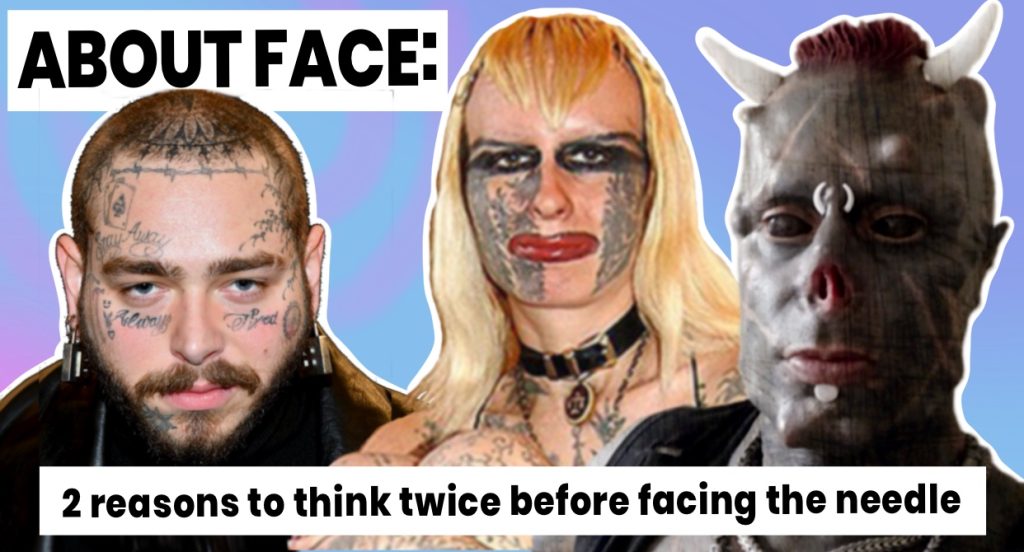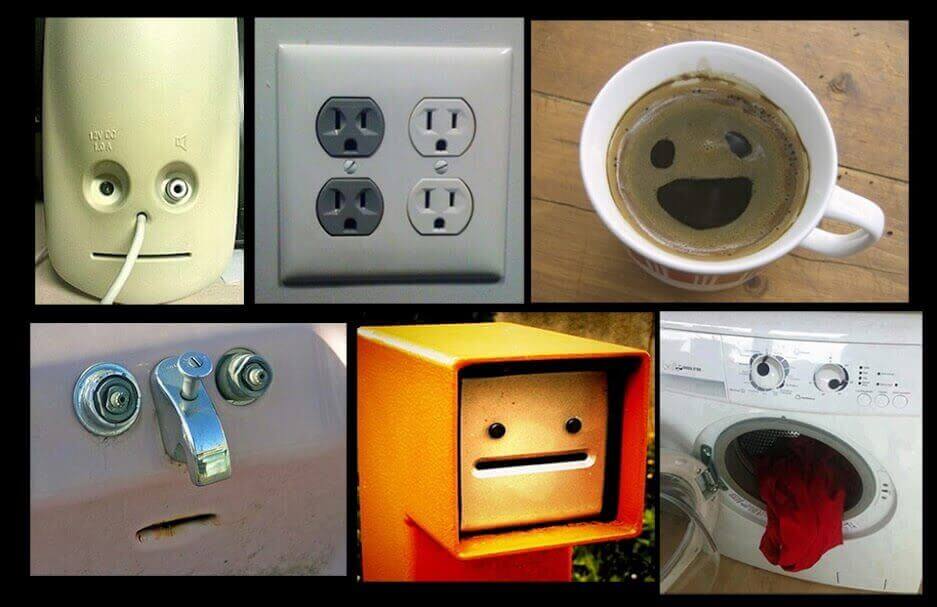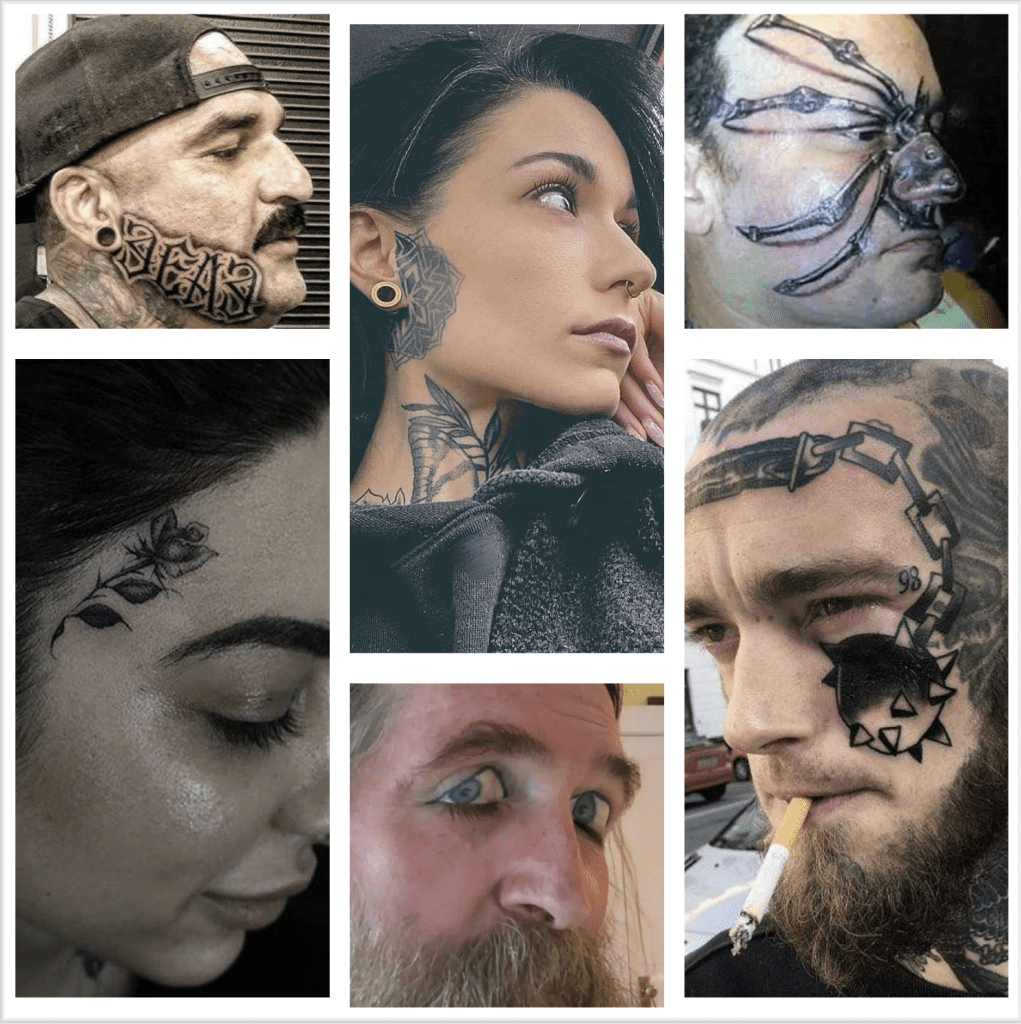
The Science and Psychology of Facial Tattoo Decisions
What could be more rad than a big ol’ tattoo right on your face? Imagine putting a gorilla’s face on your face, like some kind of face-ception. You’d never need to buy another gorilla mask again. And let’s face it, if you’re constantly losing gorilla masks like I am, that’s a real time saver. You’d definitely be the coolest parent at the PTA meeting. Those squares would freak out! It’s so punk rock.
But what could possibly go wrong, you might ask.
If you think about it for longer than the impulse to tattoo your face lasts, a few common reasons might pop up. Maybe you worry about its impact on your career or what your mom will say. What would Jesus do? But here are two areas people don’t often consider when deciding about face tattoos.
1- How humans interpret faces
Ever seen a goofy face on the front of a car or in a coffee cup? That’s pareidolia—the brain’s habit of finding faces in inanimate objects. Pareidolia is a type of apophenia, our tendency to find meaningful patterns in random data.

Pareidolia is a testament to the strength, effectiveness and subconscious reflexivity of the areas of the brain dedicated to facial perception (the fusiform face area, the occipital face area and the superior temporal sulcus). These areas developed to recognize faces, expressions, identity and intent quickly and efficiently. It happens on a subconscious level, without us even being aware that it is happening.
Immediately after that, the amygdala kicks in. This guy plays a part in emotional processing and threat detection. Within milliseconds it evaluates facial expressions, determining whether the face in question is conveying friendliness, aggression or neutrality.
A small tattoo along the hairline or where a beard would normally grow probably wouldn’t set off any red flags in these areas. But something large, noticeable and close to facial features would. It’s kind of like throwing a monkey wrench into this whole subliminal process, resulting in, at best, temporary discomfort in the viewer. (Unless that person’s dear old mum had a bitchin anchor tattooed on her face, then they just might get the ol’ warm and fuzzies).

Neuroscientist Andrew Huberman explains:
“This is very neurosciencey. The neuroscience is that we have dedicated brain areas called fusiform gyrus. It’s a face area that’s dedicated to the processing of faces. Even if i just put two dots and a line in between them on a piece of paper, you see that as a face.
When one puts a tattoo on their throat or on their face it actually changes the way that the face is perceived, right? I mean it almost looks like another mouth there, right? It’s a very different look. It can be a little bit jarring. I’m not saying one shouldn’t have it, but it can be a little bit jarring. It changes the look of the person forever.
It’s not just that it’s above the neckline. It’s that it kind of competes with the processing of their face in its normal way and so for me, whenever I see somebody with a throat tattoo or a face tattoo, sort of like, it’s hard to orient around that and I think there’s some biology that relates to that.“
-Neuroscientist Andrew Huberman
2- Psychological Resiliency
Face tattoos are a bold decision, and they come with unique psychological challenges. While tattoos are more accepted today, a visible tattoo still has the potential to draw criticism or judgment from others (See the section on social stigma in this post). For many people, this can be emotionally taxing, especially if the reactions come from authority figures like employers, police, or even family members.
Understanding and preparing for potential stigma is crucial. Visible tattoos often trigger subconscious biases in others, whether they voice them or not. Facing these reactions regularly requires a strong sense of self and a resilient mindset. Are you comfortable with the possibility of being judged—or even excluded—because of how you choose to express yourself?
Psychological resilience is about more than just enduring negative interactions; it’s about maintaining your self-worth despite them. If your self-esteem hinges on external validation, a face tattoo might amplify feelings of regret or insecurity. On the other hand, if you have a clear, deeply personal reason for your tattoo and confidence in your decision, it may feel empowering.

Before committing, consider your motivations carefully. Are you doing it to express something meaningful, or is it a way to draw attention or fit an image? If it’s the latter, speaking with a mental health professional can help you better understand these impulses and explore healthier outlets for self-expression.
Ultimately, resilience means knowing yourself and being ready to navigate the social and psychological consequences of your choices. A face tattoo is more than art—it’s a statement. Make sure it’s one you’re prepared to live with.
Conclusion
Getting a face tattoo isn’t just about making a bold statement—it’s a commitment that changes how others see you and, more importantly, how you see yourself. Your face is your first impression, the canvas for how the world interprets who you are. A tattoo here doesn’t just decorate that canvas—it redefines it, competing with natural facial cues and triggering deep-seated biases in those around you.
But beyond how others perceive it, the real question is: how will it affect you? Will it reinforce your sense of self, or will it become a source of regret? Taking the time to reflect on your motivations, consider the potential challenges, and ensure you have the psychological resilience to handle the reactions is crucial.
A face tattoo can be a powerful act of self-expression if done for the right reasons, with full awareness of what it entails. It’s not a decision to take lightly, but if it feels true to who you are, it could become a meaningful part of your identity. Just make sure you’re not doing it on a whim—because once it’s there, it’s not going anywhere!
